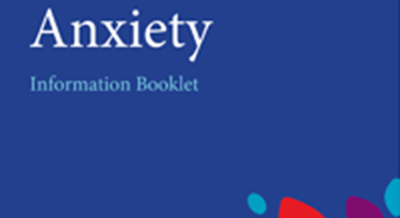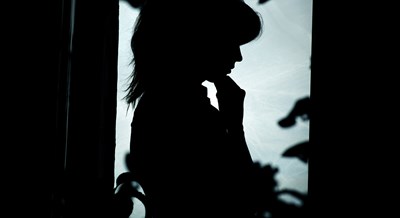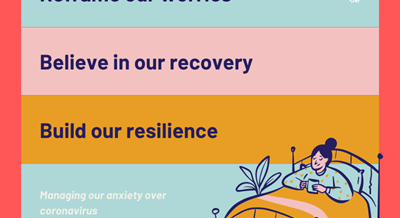What is anxiety?
We all experience anxiety from time to time; it is often a normal response to stressful situations.
When you are in a challenging situation, your body releases hormones, such as adrenaline, which cause physical reactions in your body. This is known as the ‘fight or flight response’; it is your body’s way of ensuring we are alert and can respond to danger.
At times, feeling high levels of anxiety and the ‘fight or flight response’ is very normal.
Anxiety can be a problem if you begin to regularly feel anxious when there is no threat present or your feelings of anxiety are greater than the actual danger of a situation. If you are having extreme feelings of anxiety for a long time or they are stopping you from doing your usual activities, you may be living with an anxiety disorder.
Anxiety disorders are very common. While we don’t have exact figures for Ireland, roughly one in nine people will experience an anxiety disorder in their lifetime.
The main features of anxiety disorders are:
- Altered physical sensations (palpitations, nausea)
- Altered thoughts (irrational thinking, worry)
- Altered behaviour (restlessness, avoidance)
- Altered emotions (fear, panic).
Are there different types of anxiety disorders?
There are different types of anxiety disorders with varying symptoms and triggers; you can find out more about these below. We have seen dramatic improvements in our understandings of anxiety and how it can be treated in recent years; the right support can help you manage these conditions and live a healthy life.
-
Generalised Anxiety Disorder
Generalised Anxiety Disorder (GAD) is a mental health condition where you find it difficult to control worry.
If you are living with GAD, you may spend a lot of time worrying about everyday situations, rather than single events or specific threats. You may also be very concerned about what might go wrong in the future. The anxiety coming from this worry can cause a lot of distress and may affect your social, work and home life.
Symptoms include:
- distress
- sleep disturbance
- difficulty concentrating
GAD is one of the most common anxiety disorders, affecting between 2% and 8% of the population. It can start at any time in life from childhood to adulthood.
-
Panic disorder
A panic attack is the body's way of responding to the 'flight or fight' response system being triggered when there is no actual external threat or danger present.
Approximately 20% of people will experience at least one panic attack at some time in their lives. Panic attacks can be very frightening, as they may appear to come out of the blue and can make you feel powerless or that you are losing control.
When you have a rush of adrenaline in our body, it can cause a number of different physical and emotional sensations that may affect you during a panic attack. These include:
- Very rapid breathing or feeling unable to breathe
- Palpitations or a pounding heartbeat
- Chest pain
- Dizziness, light-headedness or feeling faint
- Sweating
- Ringing in the ears
- Hot or cold flushes
- Fear of losing control
- Fear of dying.
Panic disorder is when you have sudden episodes of severe anxiety or panic, linked with a fear of death or collapse. The key feature of panic disorder is the sudden onset of panic attacks with no clear reason or trigger; you may often feel constant concern about having future attacks or about the consequences of an attack.
-
Agoraphobia
Agoraphobia is a condition where you feel anxious about being in situations where help is not easily available or that might be difficult to escape from.
You may also feel extreme worry about loss of control; socially inappropriate behavior; physical illness, such as a heart attack or fainting; and dying.
Your anxiety levels rise from anticipating that you might be stuck in a situation where they would panic. Examples of such situations include:
- Going outside of home alone
- Being in crowded public places, such as department stores or restaurants
- Using public transport, such as trains, planes, or buses
- Being in enclosed or tight spaces, such as tunnels or lifts.
These feelings might lead you to avoid a whole range of situations and day-to-day activity. In some cases, you may become house-bound or stick to a small 'safe' area.
Panic disorder is commonly linked with agoraphobia: if a panic disorder goes on for a long time, it can lead to agoraphobia.
It is estimated that 5% of people live with some degree of agoraphobia, and 1% experiences agoraphobia that significantly affects their daily lives.
-
Social anxiety
Social anxiety is when you feel intensely anxious and self-conscious in social situations. This is marked by fears of being judged negatively or appearing foolish.
Everyone can feel shy or find social situations difficult from time to time. However, social anxiety is an extreme fear which usually lasts a long time and doesn’t ease or stop on its own. Without support, it may lead you to dread, avoid or hide away in social situations. It might also stop you from taking part in performance situations, such as public speaking or job interviews.
More than one in eight people will experience social anxiety disorder at some point in their lives. For most people, it begins in the teenage years, but it can happen at any time.
Many symptoms of social anxiety are physical, such as blushing, sweating or a racing heartbeat.
If you are living with social anxiety, you might:
- See small mistakes as bigger than they really are
- Feel that all eyes are on you
- Find it difficult to do things in front of other people, like writing or talking on the phone
- Fear public speaking, dating, meeting new people or talking with people in authority
- Find blushing painfully embarrassing
- Dread being in public or social situations, such as going to parties and restaurants or using public bathrooms.
Social anxiety can impact your daily life and relationships if it leads you to avoid your normal activities or go through them in distress.
-
Obsessive Compulsive Disorder
Obsessive Compulsive Disorder (OCD) is a mental health condition where you have repeated and upsetting thoughts and behaviours. You often have a higher sense of responsibility for preventing harm and an intense awareness of risk and danger.
It is thought that 1% of the population lives with OCD at some point in their lives. OCD can begin in childhood, but it usually starts during teenage or early adult years.
There are two main features of OCD:
- Obsessions are distressing, unwanted thoughts, images or urges which happen automatically, regularly, and are difficult to control
- Compulsions, or rituals, are repeated behaviours that you intentionally carry out to respond to an obsession or to follow certain rules.
Common obsessions include:
- Worry about getting a disease, such as cancer or AIDS
- Fears about dirt, germs and contamination
- Fear of acting violently or having aggressive thoughts and urges
- Fear of harming others, especially a loved one
- Extreme concern with having to do things in a certain order or arrangement
- Fears that things are not safe, especially household appliances.
Common compulsions include:
- Excessive washing or cleaning, such as hand-washing
- Constant checking of certain things, such as whether an appliance is turned off or an item is in the right place
- Repetitive actions, such as touching or counting
- Arranging and ordering, such as moving objects in a room
- Hoarding or saving things.
While, in some cases, you can have compulsions without having obsessional thoughts, they occur together very often. Carrying out a compulsion may reduce your anxiety; however, this relief usually lasts only a short time and makes your urge to perform a compulsion again stronger each time.
OCD is a complex disorder which can have a negative impact on you and your family’s lives by affecting your routines or changing your quality of life.
-
Post-Traumatic Stress Disorder
Post-Traumatic Stress Disorder (PTSD) is an anxiety disorder that develops after very frightening, upsetting or overwhelming events.
If you are living with PTSD, you may:
- Have distressing memories or flashbacks of the event
- Avoid reminders of the event
- Withdraw from other people
- Be more alert to threat and danger
- Have disturbed sleep.
Traumatic events that can cause PTSD include natural disasters, such as earthquakes; serious car crashes or other accidents; military combat or conflict; and violent personal assaults, such as robbery or sexual assault.
It is important to distinguish PTSD from normal reactions to traumatic events, which are similar but shorter lived and less intense.
-
Specific phobias
A specific phobia is when we feel an intense fear of a particular object or situation that poses little or no actual danger.
Phobias are often present from childhood and affect roughly 10% of the population. They are automatic fears of triggers, such as rats, spiders, heights, enclosed spaces or, more unusually, vomiting or thunderstorms.
Phobias are linked with an intense desire to avoid or escape from the trigger. The feelings of fear and avoidance are strong enough that they can cause a lot of distress or significantly interfere with your normal routine, social activities and relationships.
The most common specific phobias include:
- fear of closed spaces (claustrophobia)
- fear of water (aquaphobia)
- fears of animals, such as snakes, bats, rats.
- fears of reptiles or crawling things, like spiders (herpetophobia)
- fear of heights (acrophobia)
- fears of blood or injury
- fear of becoming sick with or dying from a specific illness, such as a heart attack or cancer.
What causes anxiety disorders?
Anxiety disorders can begin at any time in our lives, from childhood and adolescence to adulthood.
Anxiety can be the primary, or main, mental health problem. This means that symptoms happen independently of other mental health problems and tend to follow a set pattern over several months or years; they can also feel more intense if we are going through stressful times.
Primary anxiety disorders are thought to result from a combination of our genetics and life stresses, which create a vicious cycle. Physical reactions in the brain and body interact with both distorted thoughts about danger and patterns of behavior, such as avoidance, to grow and maintain a state of anxiety.
Anxiety can also be a secondary problem, which means that it is a symptom of another mental health disorder. Often, one anxiety disorder can be related to another, such as agoraphobia combined with panic disorder. There are also links between anxiety disorders and other mental health conditions, such as depression or substance misuse; in these cases, the underlying problem should be treated rather than the symptoms of anxiety alone.
Is there treatment for anxiety?
Cognitive Behavioural Therapy (CBT) is highly effective in treating anxiety disorders. By learning about the vicious cycle of anxiety and challenging unhelpful beliefs and behaviours, you can gradually master your fears, grow your confidence and regain your functioning through CBT.
CBT can also be supported by other forms of help, such as mindfulness, meditation and occupational therapy.
You may also benefit from taking medication. For example, sedative anti-anxiety drugs can be used for a short time to ease the worst anxiety symptoms. Serotonin boosting anti-depressant drugs can also be very helpful in easing anxiety and supporting CBT work.
Our Anxiety Disorders Programme provides care in an outpatient, day patient or inpatient setting, according to your needs. Please note that PTSD is not part of the Anxiety Disorders Programme; however, our Anxiety Disorders Service will assess PTSD and treat it individually.
Find out more about anxiety and its treatment
Useful resources
-
Websites
-
Books
Overcoming series
- Overcoming Body Image Problems including Body Dysmorphic Disorder | David Veale, Rob Willson and Dr Alex Clarke
- Overcoming Obsessive Compulsive Disorder | David Veale and Rob Willson
- Overcoming Panic | Derrick Silove and Vijaya Manicavasagar
- Overcoming Perfectionism | Roz Shafran, Sarah Egan and Tracey Wade
- Overcoming Social Anxiety and Shyness | Gillian Butler
- Overcoming Traumatic Stress | Claudia Herbert and Ann Wetmore
- Overcoming Worry | Paul Gilbert
More reading
- How to Stop Worrying | Frank Tallis
- Living with Fear: Understanding and Coping with Anxiety | Isaac M Marks
- The Worry Cure | Dr Robert L Leahy
- Understanding Panic Attacks and Overcoming Fear | Dr Roger Baker
Check our Information Centre for availability and a wider selection of books.
Continue to…
Bipolar Disorder





